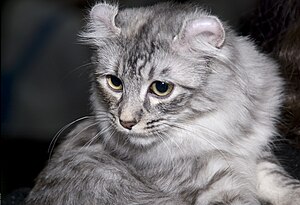American curl
| American curl | |||
|---|---|---|---|
|
|||
| Fur length: | Semi-longhair cat | ||
| Weight: | Male cat: ? kg female:? kg |
||
| Breeding standards: |
|
||
| List of cat breeds | |||
The American Curl is a breed of domestic cat .
description
The most noticeable feature of this breed is its back curved ears . This peculiarity is the result of a mutation . The ears feel immobile and stiff and are framed with fur.
In 1981 , a Californian couple discovered a long-haired cub with strange ears. A little later this female gave birth to four cubs, two of whom had inherited crooked ears. The breed belongs to breed category II, the semi-long-haired breeds. There is a variant with longer hair and one with shorter hair.
In all American Curl young animals, the ears only pucker up after four to seven days. The final shape shows up at four months of age. The curvature of the auricle varies from animal to animal. In extreme cases, the angle can be up to 180 °. Nevertheless, their ears are extremely flexible and the cat can turn them in all directions. Adult animals with normal ears represent a separate variety , the American Curl Straight Ear . The cats' hearing is not affected by the curled ears. They hear just as well as any other cat.
If both parents have curved ears, then all of the offspring will have rolled ears too. If one parent has rolled ears and is homozygous, but the other parent has normal ears, then all of the offspring there will also have rolled ears. If one parent has rolled ears but is heterozygous and the other parent has normal ears, then only 50% of the offspring have rolled ears.
The ears feel immobile and stiff and are framed with fur. In principle, they are constructed like human ears. Two thirds is ear cartilage and is very hard and stiff, one third is soft like all other cats. That's why this part rolls backwards. The babies are initially born with straight ears. These initially curl up two to ten days after birth, only to relax again in the following four months and assume the ear shape that is typical for adult animals. The ears are broad at the base, medium-sized, set upright, the tips are rounded. They are set high and far on the outside of the head. The tips of the ears point towards the center of the back of the head, a clear curl is preferred. They are hairy on the inside and have tufts of ears.
The so-called degree of curvature is important for determining the quality of the cat (pet, breeding / show animal):
- 1st degree: lover animal
- 2nd and 3rd degree: breeding or show animal
- The 3rd degree is the most valued, here a crescent moon is described in an elegant curve. The ears are big. From the medium-wide base, initially straight (2/3), then tapering off in a tip bent backwards (1/3). The tips of the ears are curved and flexible. You must not touch the back of your ear. The angle of the bend must be in the range of 90 to 180 degrees.
url.de
maintenance
The American Curl is easy to care for. However, your fur should still be brushed regularly so that the silky shine is not lost. With long-haired cats you have to brush much more frequently during the twice-yearly coat change. According to the breed standard, American Curls have little undercoat and the fur lies flat, the collar is nowhere near as strong as that of the Norwegian Forest Cat or the Maine Coon .
genetics
The gene responsible for the shape of the auricle was named Cu. Mating normal and curl cats resulted in an autosomal dominant inheritance. Mating female curls with normal males resulted in 103 curls and 98 normal cats. Here the sex was roughly evenly distributed. If curls were paired with each other, a 3: 1 distribution of curls to normal cats was obtained. Since homozygous kittens can develop osteochondrodysplasias in another breed with ear anomalies ( Scottish Fold ) when two fold- ear cats are mated, one was also careful with the American Curl. However, animals with the genotype CuCu (i.e. homozygous) were viable and even after two years of observation, there were still no findings.
Web links
- Breed standard of the FIFe (PDF; 178 kB)
- Description with pictures
Individual evidence
- ↑ American Curl. (No longer available online.) In: www.paladija-curl.de. Archived from the original on April 24, 2016 ; accessed on November 18, 2018 . Info: The archive link was inserted automatically and has not yet been checked. Please check the original and archive link according to the instructions and then remove this notice.
- ^ Roy Robinson: The American Curl Cat. In: Journal of Heredity. Vol. 80, No. 6, 1989, ISSN 0022-1503 , pp. 474-475, doi : 10.1093 / oxfordjournals.jhered.a110902 .
- ↑ OF. Jackson: Congenital bonelesions in cats with folded ears. In: The Bulletin of the Feline Advisory Bureau. Vol. 14, No. 4, 1975, ZDB -ID 286168-9 , pp. 2-4.
- ^ Roy Robinson: The American Curl Cat. In: Journal of Heredity. Vol. 80, No. 6, 1989, pp. 474-475, doi : 10.1093 / oxfordjournals.jhered.a110902 .


